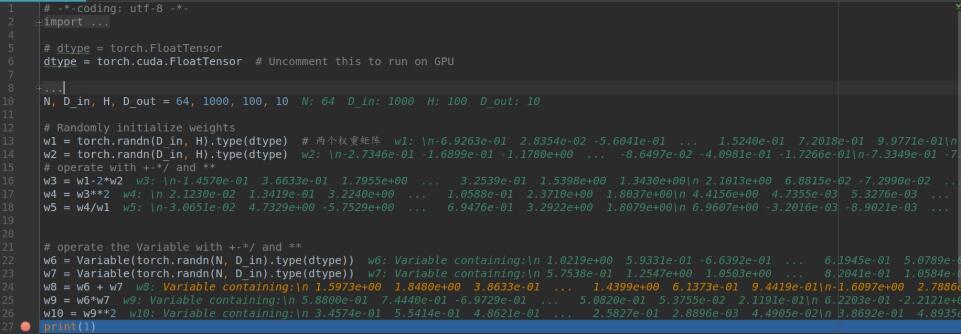pytorch中基本的变量类型当属FloatTensor(以下都用floattensor),而Variable(以下都用variable)是floattensor的封装,除了包含floattensor还包含有梯度信息
pytorch中的dochi给出一些对于floattensor的基本的操作,比如四则运算以及平方等(链接),这些操作对于floattensor是十分的不友好,有时候需要写一个正则化的项需要写很长的一串,比如两个floattensor之间的相加需要用torch.add()来实现
然而正确的打开方式并不是这样
韩国一位大神写了一个pytorch的turorial,其中包含style transfer的一个代码实现
|
1
2
3
4
5
6
7
8
9
10
11
12
13
14
15
16
17
18
19
20
21
22
23
24
25
|
for step in range(config.total_step): # Extract multiple(5) conv feature vectors target_features = vgg(target) # 每一次输入到网络中的是同样一张图片,反传优化的目标是输入的target content_features = vgg(Variable(content)) style_features = vgg(Variable(style)) style_loss = 0 content_loss = 0 for f1, f2, f3 in zip(target_features, content_features, style_features): # Compute content loss (target and content image) content_loss += torch.mean((f1 - f2)**2) # square 可以进行直接加-操作?可以,并且mean对所有的元素进行均值化造作 # Reshape conv features _, c, h, w = f1.size() # channel height width f1 = f1.view(c, h * w) # reshape a vector f3 = f3.view(c, h * w) # reshape a vector # Compute gram matrix f1 = torch.mm(f1, f1.t()) f3 = torch.mm(f3, f3.t()) # Compute style loss (target and style image) style_loss += torch.mean((f1 - f3)**2) / (c * h * w) # 总共元素的数目? |
其中f1与f2,f3的变量类型是Variable,作者对其直接用四则运算符进行加减,并且用python内置的**进行平方操作,然后
|
1
2
3
4
5
6
7
8
9
10
11
12
13
14
15
16
17
18
19
20
21
22
23
24
25
26
27
|
# -*-coding: utf-8 -*-import torchfrom torch.autograd import Variable# dtype = torch.FloatTensordtype = torch.cuda.FloatTensor # Uncomment this to run on GPU# N is batch size; D_in is input dimension;# H is hidden dimension; D_out is output dimension.N, D_in, H, D_out = 64, 1000, 100, 10# Randomly initialize weightsw1 = torch.randn(D_in, H).type(dtype) # 两个权重矩阵w2 = torch.randn(D_in, H).type(dtype)# operate with +-*/ and **w3 = w1-2*w2w4 = w3**2w5 = w4/w1# operate the Variable with +-*/ and **w6 = Variable(torch.randn(N, D_in).type(dtype))w7 = Variable(torch.randn(N, D_in).type(dtype))w8 = w6 + w7w9 = w6*w7w10 = w9**2print(1) |
基本上调试的结果与预期相符

所以,对于floattensor以及variable进行普通的+-×/以及**没毛病
以上这篇Pytorch基本变量类型FloatTensor与Variable用法就是小编分享给大家的全部内容了,希望能给大家一个参考,也希望大家多多支持服务器之家。
原文链接:https://blog.csdn.net/u013517182/article/details/93051322










